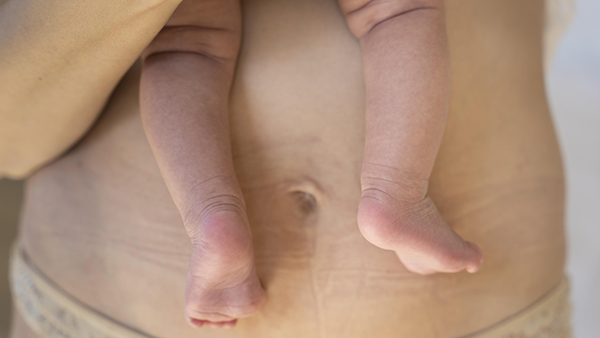More about tearing
Most women experience some level of tearing during childbirth. After you have given birth, the care provider will examine you to see if you have a tear and, if so, what type of tear it is.
Read time: 3 m
Verified by Ingela Ågren
Certified Midwife
After you have given birth, the care provider checks if you have a tear that needs stitches. You will be given a local anesthetic before the examination and stitches to relieve discomfort. You might be given a pudendal nerve block. You must get the proper anesthetic. However, you'll be able to feel the examination, which might be uncomfortable. When the care team examines the tear you'll have your feet in stirrups so they can see properly. It is common for two doctors to examine you to make sure they assess the tear correctly. To assess if there is an injury involving the sphincter muscle, the person examining usually checks the anus with one finger. While you're being examined, you can hold your baby for skin-to-skin contact if you wish.
Types of tears:
Tears are graded on a scale of 1-4. If you had an episiotomy cut it's always classed as a grade 2 tear.
Grade 1: Superficial tears in the lining of the vagina or labia. Most women who give birth experience grade 1 tear. These often heal quickly without causing long-term issues. Some minor tears can heal without the need for stitches.
Grade 2: In a grade 2 tear, the pelvic floor muscles are damaged. About eight out of ten first-time mothers experience a grade-2 tear when they give birth. A grade 2 tear always needs stitches to heal properly. Episiotomy: When the baby's head is protruding, an episiotomy cut is sometimes necessary, which is a cut in the perineum. This may be the case if the baby needs to be delivered quickly due to distress or to avoid a grade 3 or 4 tear. The episiotomy cut is carried out by a doctor and you will be given an anesthetic beforehand. This type of cut always cuts through the pelvic floor muscles.
Grade 3 and 4: A grade 3 or 4 tear means that the sphincter muscle is damaged. The lining of the intestine may also have broken. In 2017, a total of approximately 2.9% of all women who gave birth vaginally experienced a sphincter injury. 5.4% of these injuries were first-time births and 1.3% were repeated births. It is more common to experience a sphincter injury if a ventouse is used. Grade 3 and 4 tears are usually treated in a surgical ward by a doctor and you will have a follow-up appointment at the clinic where you gave birth.
The doctor will usually show you where the tear is and what type of tear you have experienced. The information will also be recorded in your medical record.
All tears are treated with stitches that disappear on their own. Tears usually heal on their own but it can take a while to recover completely. After a few months, most women will have recovered but for some women, it takes up to a year to recover fully.
Verified by Ingela Ågren
Certified Midwife
More from Preggers
Hundreds of related articles, podcasts & more waiting for you in the Preggers app.
Download Preggers today.

